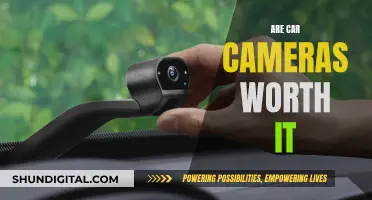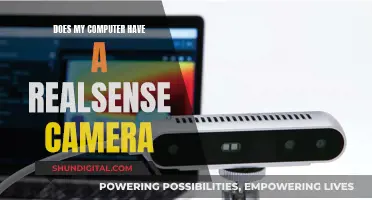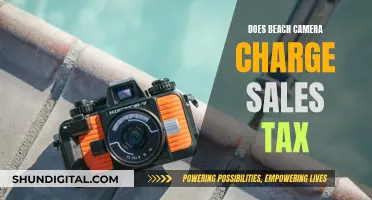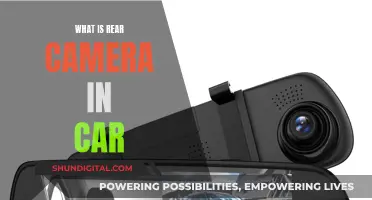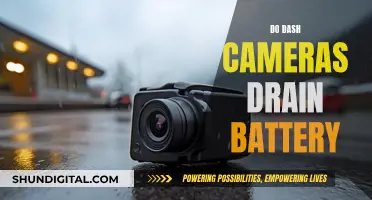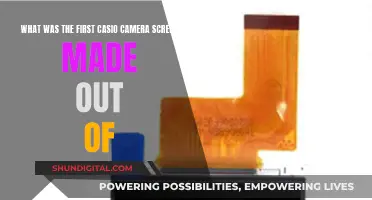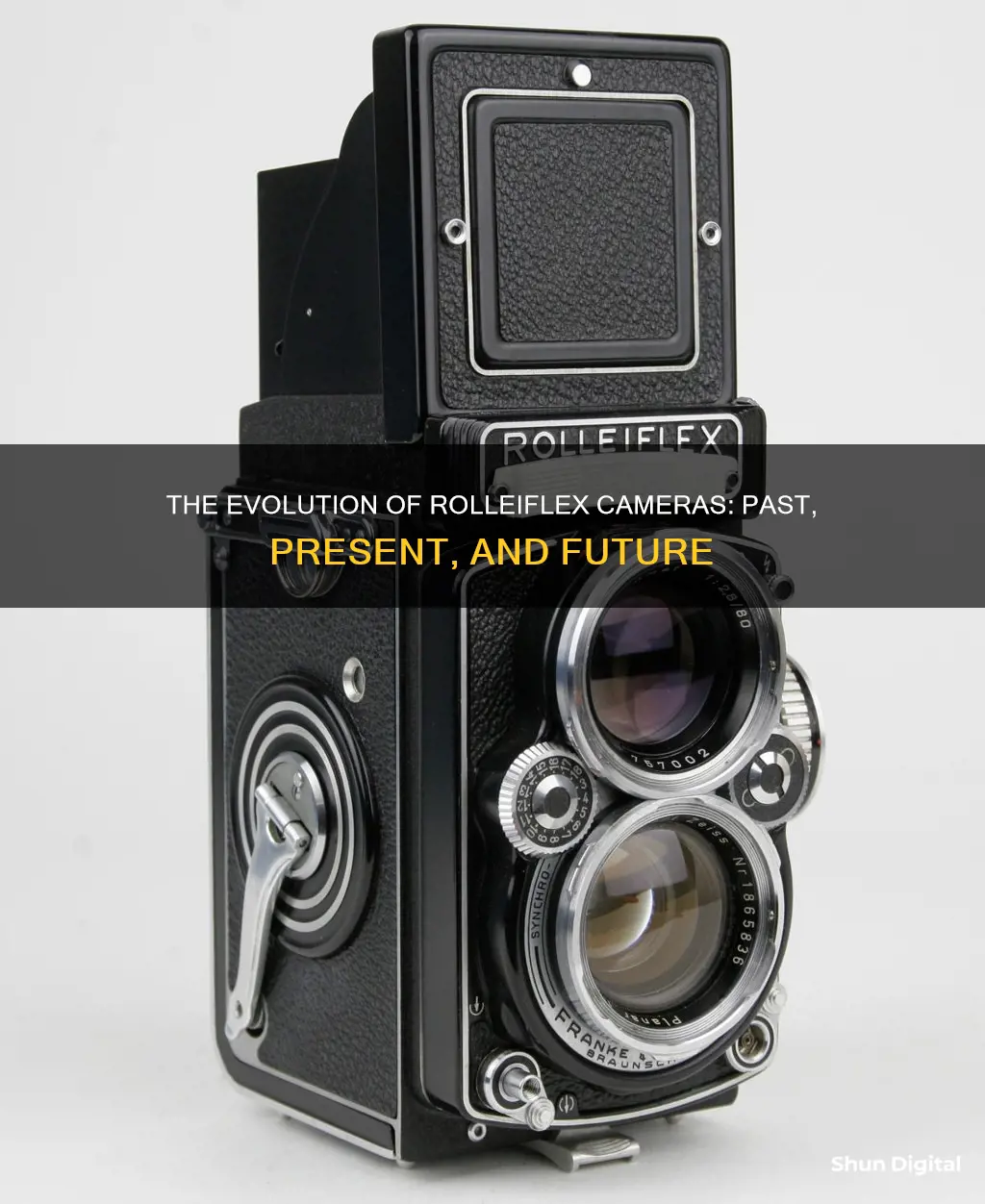
The Rolleiflex is a twin-lens reflex camera, first made in 1927 by the German manufacturer Rollei. The company has changed hands many times since then, and has been known by various names, including Rollei-Werke Franke & Heidecke, Rollei Fototechnic, Franke & Heidecke, and DHW Fototechnik. The Rolleiflex TLR was a widely used professional camera, but its popularity declined with the introduction of more versatile SLR cameras in the 1950s and 60s. However, the Rolleiflex TLR remains sought-after by collectors and photography enthusiasts, with some models still in production today.
| Characteristics | Values |
|---|---|
| Brand | Rollei |
| Manufacturer | Franke & Heidecke |
| Type of camera | Twin-lens reflex camera |
| Year of first Rolleiflex | 1927 |
| Film format | 6x6 |
| Film type | 120 |
| Lens | Carl Zeiss or Schneider Kreuznach |
| Lens mount | Bayonet |
What You'll Learn

The history of the Rolleiflex camera
The Rolleiflex camera was first introduced in 1928 by the German company Franke & Heidecke. It was a twin-lens reflex roll-film camera with two lenses of identical focal length, one for transmitting the image to the film and the other for viewing and focusing. The camera was extremely popular with both amateur and professional photographers due to its durability, precision, and compactness.
The original Rolleiflex used 117 (B1) film, which was unpopular at the time. Later models used 120 roll film, which was marketed primarily to professional photographers, and 127 film, which was used in the Rolleiflex 4x4, also known as the Babyflex outside of Germany. The company continued to innovate and release new models, such as the Rolleiflex Automat in 1937, which combined the steps of advancing the film and cocking the shutter, and the Rolleiflex SL2000F in 1981, a 35mm SLR camera with interchangeable film backs and dual viewfinders.
Over the years, the company changed its name and legal form many times, and its ownership also changed hands several times. In the 1970s, Rollei faced increasing competition from Japanese camera manufacturers and struggled financially. Despite these challenges, the Rolleiflex remained a well-regarded camera, with several models released in the following decades.
In 2009, Franke & Heidecke filed for bankruptcy, and a new company, DHW Fototechnik, was founded by former employees to continue production of Rolleiflex cameras and accessories. DHW Fototechnik itself filed for insolvency in 2014 and was dissolved in 2015, ending production of Rolleiflex cameras once again. However, a smaller company called DW Photo, formed by the same management team, continues to produce the Hy6 medium format SLR camera.
The Raw Camera Filter: Where Did It Go?
You may want to see also

The Rolleiflex TLR camera's unique features
The Rolleiflex TLR cameras have several unique features that set them apart from other cameras. Here are some of the key features:
- Twin-Lens Reflex (TLR) Design: Rolleiflex TLR cameras are known for their distinctive twin-lens design, with one lens serving as the viewfinder and the other as the imaging lens. This allows for a unique viewing experience and makes these cameras easily recognisable.
- Compact Size: Despite being professional cameras, Rolleiflex TLR cameras are relatively compact and lightweight, making them easy to carry and transport, especially with the use of a waistband that comes with some models.
- Manual Film Advance Crank: The manual film advance crank on Rolleiflex TLR cameras serves multiple functions. One turn of the crank activates the exposure counter, sets the film spacing, and tensions the shutter, making the process of taking photographs more efficient.
- Variety of Photo Effects and Accessories: Rolleiflex TLR cameras offer a range of photo effects and accessories, such as panorama heads, sunshades, close-up lenses, and various photo filters. These accessories enhance creativity and allow photographers to achieve different visual styles.
- External Flashbulbs: Rolleiflex TLR cameras support external flashbulbs, reminiscent of the early days of photography. This feature adds to the vintage feel of the camera and provides creative options for photographers.
- Interchangeable Lenses: Some Rolleiflex TLR cameras offer interchangeable lenses, allowing photographers to use different focal lengths and specialised lenses for specific types of photography.
- Durability and Longevity: Rolleiflex TLR cameras are known for their durability and longevity, with some models still functioning decades after their production. This makes them sought-after by collectors and photography enthusiasts.
- Versatility: Rolleiflex TLR cameras have been used by a diverse range of photographers, from students and filmmakers to portrait and wedding photographers. The versatility of these cameras allows them to capture a wide variety of subjects and scenes.
Mastering Camera Modes: AV vs TV Settings
You may want to see also

The pros and cons of the Rolleiflex TLR camera
The Rolleiflex TLR camera is a high-end, medium-format twin-lens reflex camera. It has a unique design and offers several advantages over single-lens reflex cameras. Here are some pros and cons of the Rolleiflex TLR camera:
Pros:
- Image Quality: Rolleiflex TLR cameras are known for their exceptional image quality. They use high-quality lenses, such as the Zeiss Planar f2.8 and Schneider Xenotar lenses, which are state-of-the-art optics.
- Build Quality: Rolleiflex cameras are built to last. They are constructed primarily of metal and glass and covered with luxurious leather. The precise manner in which parts fit together showcases exacting craftsmanship, making them solid and a joy to hold.
- Viewfinder: The waist-level viewfinder offers a unique shooting perspective, making subjects appear more "heroic." Additionally, the TLR design provides a larger viewfinder image than most SLRs, making it easier to compose shots.
- Shutter and Mirror: The TLR design features a stationary mirror, which reduces vibration and allows for quieter operation compared to SLRs. The absence of a moving mirror also means the viewfinder doesn't go dark during exposure.
- Accessories: Rolleiflex TLR cameras have a range of accessories, including panorama heads, sunshades, parallax-corrected close-up lenses, filters, and quick-release tripod attachments.
- Format: Rolleiflex TLR cameras use a 6 x 6 cm square format, which offers more flexibility in cropping compared to the horizontal format of most SLRs.
Cons:
- Price: Rolleiflex TLR cameras can be expensive, especially the newer models and those with better features. The cost can vary drastically, and finding one in pristine condition can be challenging.
- Learning Curve: Using a Rolleiflex TLR camera for the first time can be comical, as the mirror reverses the viewfinder image. This can cause confusion when moving the camera, and it takes practice to get used to.
- Maintenance: Due to their age and delicate mechanics, Rolleiflex TLR cameras often require regular servicing and maintenance. This includes cleaning, lubrication, and adjustments (CLA). Buyers should be prepared to spend extra on servicing these vintage cameras.
- Weight and Size: While Rolleiflex TLR cameras are known for their compact size and modest weight, they may still be bulkier and heavier than some modern cameras, making them less portable.
- Film: Rolleiflex TLR cameras use 120 roll film, which offers only 12 exposures per roll. This can be inconvenient, as it requires frequent film changes and reloading.
Applying Camera Raw Filter: Enhancing Your Photos
You may want to see also

Tips for buying a used Rolleiflex TLR camera
Rolleiflex cameras have been manufactured for nearly a century, so it's important to be aware of the differences between models when buying a used one. Here are some tips to help you make an informed decision:
- Identify the model: Rolleiflex cameras can be broadly categorised into four groups: the Rolleiflex Standard, the Automat, the 3.5, and the 2.8. The newer the camera, the more expensive it is likely to be.
- Understand the features: The cost of a Rolleiflex depends on its features. For example, a 2.8 model will typically cost more than a 3.5 model from the same era. Consider what features are important to you, such as a working light meter or user-changeable focus screens.
- Check the lens: Rolleiflex cameras use different types of lenses, including Tessar, Planar, Xenotar, and Biometar. While all these lenses are excellent, Planar and Xenotar lenses are generally considered to be superior to Tessar and Xenar lenses.
- Consider the filter mount: Rolleiflex cameras use different filter mounts – Bay I, Bay II, and Bay III. Bay I accessories are the most affordable, while Bay III accessories can be hard to find and expensive.
- Inspect the condition: Used Rolleiflex cameras may have issues such as haze, fungus, or element separation in the lenses, or worn-out film transport mechanisms. Make sure to check the camera thoroughly before buying, and ensure that the price reflects any issues.
- Buy from a reputable seller: Consider buying from a reputable camera shop that tests its products and offers a warranty. If buying online, do your research on the camera and the seller to avoid any issues.
- Decide on your budget: Rolleiflex cameras can vary drastically in price, so it's important to set a budget before you start shopping. This will help you narrow down your options and find a camera that suits your needs and budget.
Charging Your SeaLife Camera: A Step-by-Step Guide
You may want to see also

The Rolleiflex TLR camera's legacy and influence
The Rolleiflex TLR cameras are a long-running line of high-end cameras originally made by the German company Franke & Heidecke, and later Rollei-Werke. The first Rolleiflex was introduced in 1929 and was the company's first medium format roll-film camera. Over the years, the Rolleiflex TLR cameras have become known for their exceptional build quality, compact size, modest weight, superior optics, durability, simplicity, reliable mechanics, and bright viewfinders. The high-quality 7.5 cm focal length lenses, manufactured by Zeiss and Schneider, allowed for a smaller, lighter, and more compact camera than their competitors.
The Rolleiflex TLR cameras have had a significant influence on the world of photography and have been used by many renowned photographers, including Robert Capa, David Bailey, Diane Arbus, Brett Weston, and Helmut Newton. The cameras were particularly popular with press photographers and amateurs alike in the 1950s. The cameras were so popular that they bred over 500 imitations, more than half of them from Japan.
The Rolleiflex TLR cameras were also known for their innovative features, such as the mechanical wind mechanism in the Rolleiflex Automat and letter model cameras, which made film loading semi-automatic and quick. This feature started the exposure counter automatically and tensioned the shutter, making these models very sought-after for shooting fast-paced action, such as street photography.
In addition to their technical specifications and performance, the Rolleiflex TLR cameras have also left a legacy in terms of their design and aesthetics. The cameras had a distinctive look, with their twin-lens reflex system and compact size. This unique design has made them popular not only with photographers but also with collectors, and there is an active market for many Rolleiflex models as collectibles.
Today, the Rolleiflex TLR cameras are still sought after by photographers and collectors alike, and they remain a testament to the company's commitment to quality and innovation. While the original company that produced them may no longer exist, the "Rolleiflex" name continues to be owned by the RCP Technik Verwaltungs GmbH, and the cameras are still serviced and sold by specialised dealers.
Activating Camera Mode in Blender: A Step-by-Step Guide
You may want to see also
Frequently asked questions
Yes, Rolleiflex cameras are still being made. The company has changed hands many times since its founding in 1920 and has been known by several names, including Rollei GmbH and Franke & Heidecke. As of 2015, the brand is owned by RCP-Technik GmbH & Co. KG, which markets digital consumer cameras and accessories under the "Rollei" label in Europe.
Some popular Rolleiflex camera models include the Rolleiflex 2.8F, 3.5F, and 2.8E, as well as the Rolleicord IIB Model 3 K3 TLR Film Camera and the Rolleiflex 4x4 Baby Grey Gray TLR 127 Film Camera.
Rolleiflex cameras can be purchased from various retailers, including eBay, B&H, and UsedPhotoPro.


